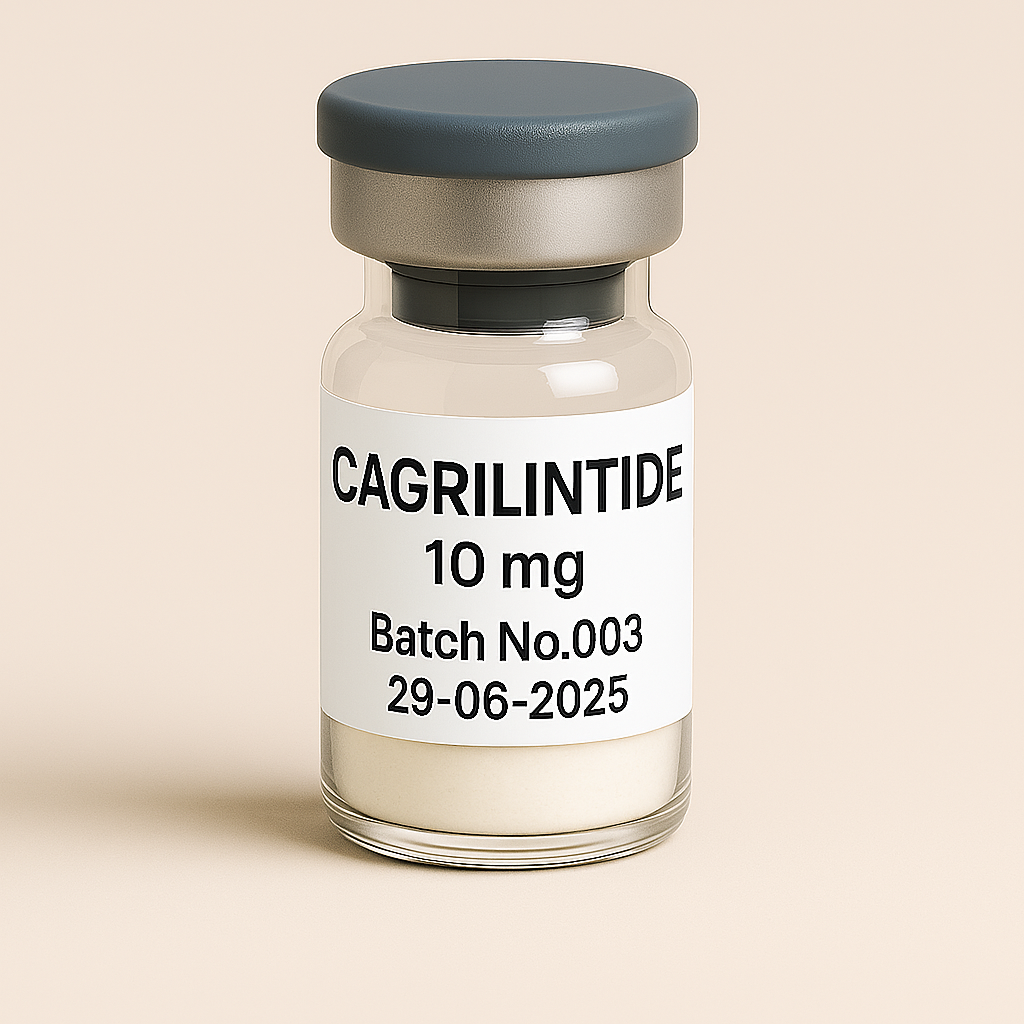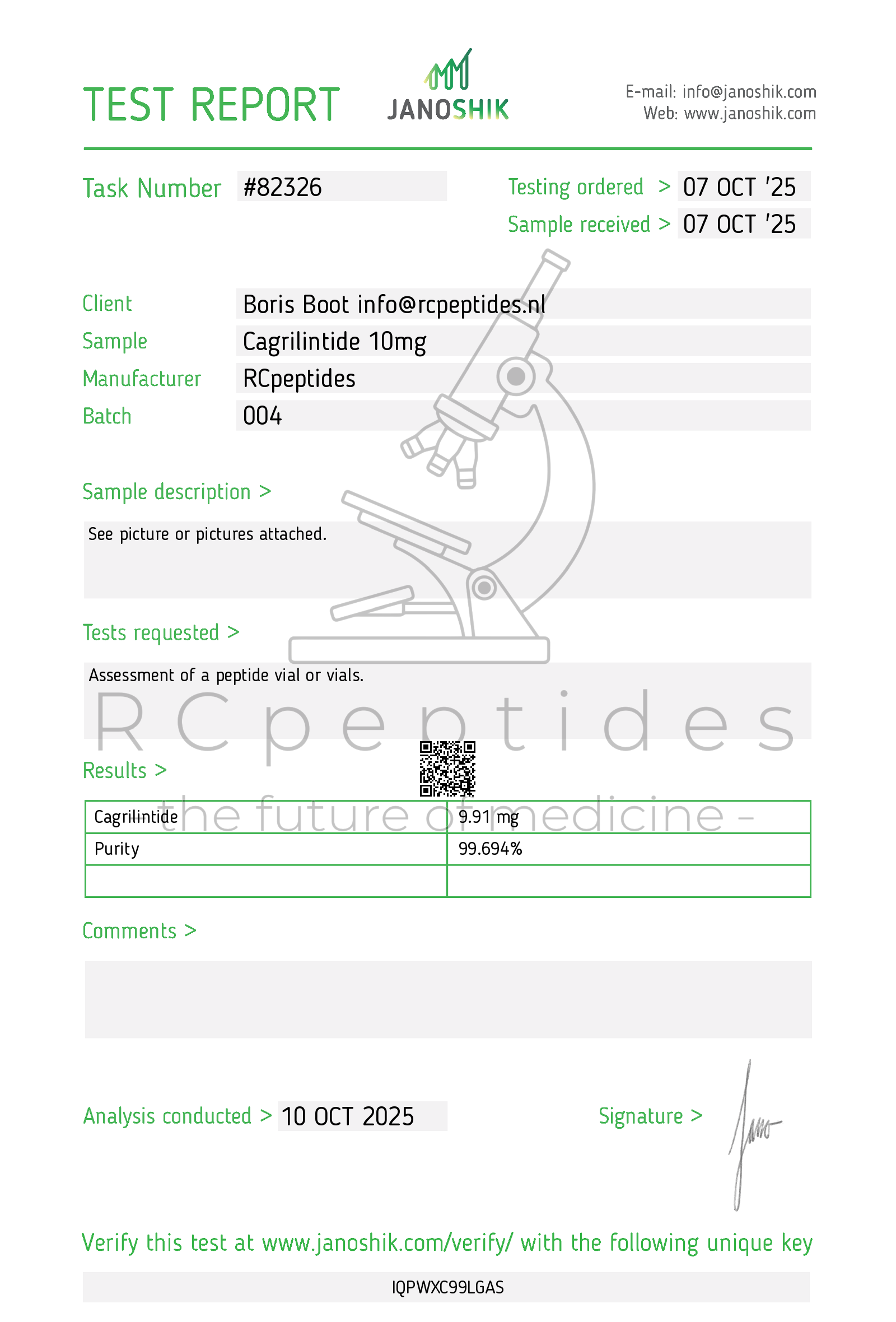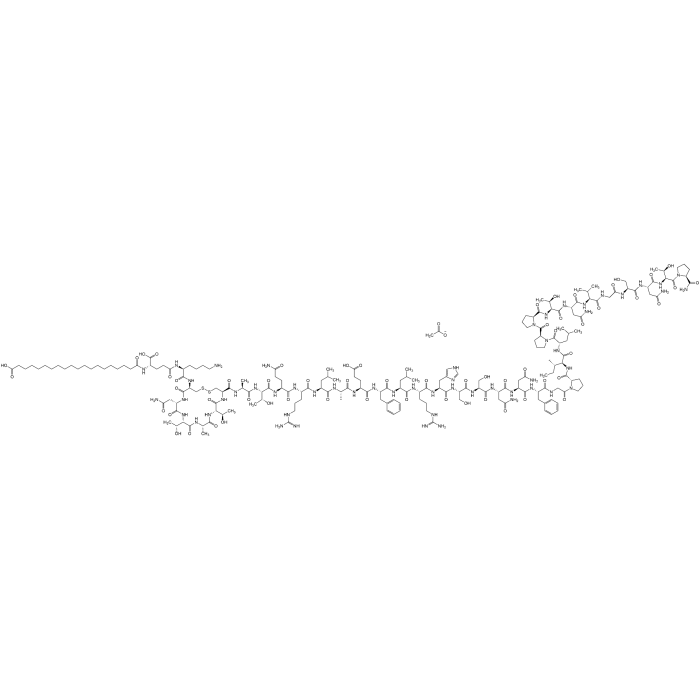
Cagrilintide 10mg vial
Pickup currently not available
NOT FOR HUMAN CONSUMPTION
Cagrilintide is a novel, long-acting amylin analogue under development primarily for obesity management and type 2 diabetes mellitus (T2DM). It mimics and extends the physiological effects of endogenous amylin—a pancreatic hormone co-secreted with insulin—by regulating gastric emptying, satiety, and food intake. Cagrilintide is administered once weekly via subcutaneous injection and is being investigated both as monotherapy and in combination with semaglutide, a GLP-1 receptor agonist, in a dual-agonist formulation referred to as CagriSema.
2. Mechanism of Action
Cagrilintide exerts its pharmacologic effects through dual receptor activation:
-
Amylin Receptor Agonism: Enhances satiety, delays gastric emptying, and reduces postprandial glucagon secretion.
-
Calcitonin Receptor Agonism (minor activity): Contributes to appetite regulation and weight modulation.
This dual activity distinguishes cagrilintide from endogenous amylin and its predecessor, pramlintide, by offering prolonged receptor engagement and greater weight-reduction potential.
3. Clinical Efficacy
3.1. Monotherapy Trials
In a Phase 2 randomized, placebo-controlled trial (Marre et al., The Lancet, 2021), over 300 adults with obesity received varying doses of cagrilintide (0.3–4.5 mg) or liraglutide 3.0 mg daily for 26 weeks. Results included:
-
Mean weight reduction of up to 8.1% at the highest cagrilintide dose.
-
Superior weight loss versus liraglutide (6.8%) and placebo (1.6%).
-
Improvements in waist circumference, systolic blood pressure, and patient-reported appetite scores.
3.2. Combination Therapy (CagriSema)
Cagrilintide has shown remarkable synergy when combined with semaglutide:
Phase 2 Trial (CagriSema vs. Semaglutide vs. Cagrilintide Alone):
-
Population: Adults with T2DM and overweight or obesity.
-
Duration: 32 weeks.
-
Findings:
-
CagriSema: ~15.6% weight loss.
-
Semaglutide 2.4 mg alone: ~5.1%.
-
Cagrilintide 2.4 mg alone: ~8.1%.
-
This indicates an additive or possibly synergistic effect when both agents are used concurrently.
REDEFINE 2 Phase 3 Trial (2024, Novo Nordisk):
-
Population: Adults with T2DM and BMI ≥27 kg/m².
-
Duration: 68 weeks.
-
Results:
-
CagriSema group: 15.7% mean weight loss.
-
Placebo group: 3.1%.
-
Also noted improvements in HbA1c, fasting glucose, and lipid profiles.
-
4. Safety and Tolerability
Across studies, cagrilintide has demonstrated a favorable safety profile:
-
Most common adverse events: Gastrointestinal symptoms (nausea, vomiting, constipation), dose-dependent and transient.
-
Hypoglycemia risk: Minimal when used without insulin or insulin secretagogues.
-
Cardiac safety: No significant QT prolongation; no increase in major adverse cardiovascular events (MACE).
-
Immunogenicity: Low incidence of anti-drug antibodies; no impact on efficacy observed.
5. Pharmacokinetics
-
Half-life: Approximately 150 hours, supporting once-weekly dosing.
-
Absorption: Delayed Tmax (~72 hours), with stable weekly plasma concentrations.
-
Elimination: Renal excretion is minor; no dose adjustment required for mild/moderate renal impairment.
6. Clinical Development and Future Outlook
Cagrilintide is part of Novo Nordisk’s REDEFINE clinical trial program, targeting both monotherapy and dual-therapy use:
-
REDEFINE 1–6 Trials: Ongoing Phase 3 studies in various patient subgroups (obesity, T2DM, prediabetes).
-
Combination Focus: CagriSema is expected to be a first-in-class dual peptide for chronic weight and glucose management.
-
Potential indications: Obesity, T2DM, metabolic syndrome, possibly for cardiovascular risk reduction pending outcomes.
If regulatory approval is granted, CagriSema could redefine obesity pharmacotherapy, offering superior efficacy with manageable tolerability.
7. Conclusion
Cagrilintide represents a significant advancement in metabolic therapeutics. Its ability to induce meaningful weight loss, especially in combination with GLP-1 agonists like semaglutide, places it at the forefront of next-generation obesity and diabetes management. Pending long-term safety and cardiovascular outcome data, it holds promise for widespread clinical adoption.
Key References
-
Marre M, et al. The Lancet, 2021. DOI: 10.1016/S2213-8587(21)00203-0
-
Davies M, et al. Lancet Diabetes Endocrinol., 2023. PMID: 37364590
-
Rosenstock J, et al. Diabetes Obes Metab., 2023. DOI: 10.1111/dom.15951
-
Novo Nordisk press release: REDEFINE 2 Trial Results, 2024
-
Wadden TA, et al. Obesity, 2024. Clinical implications of CagriSema dual therapy.



